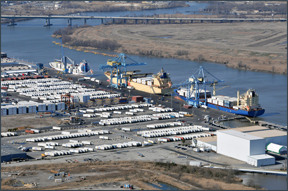Port of Wilmington, Delaware Marks its 90th Anniversary
(Wilmington, Del.) – Exciting international trade opportunities
supporting the export and manufacturing requirements of the local ship
building, railroad car construction and carriage making industries as
well as those of an industrial area encompassing 5 million people in
five states were envisaged when the Board of Harbor Commissioners of the
City of Wilmington opened the Port of Wilmington for commerce on May 2,
1923. As we commemorate the Port of Wilmington’s 90th Anniversary, we
also celebrate its growth from then, a hundred acre facility with three
berths, 25 feet depth of water at its berths and two storage sheds, to
today, a world-class marine terminal encompassing 308 acres, offering 10
operating deep-water berths, over 1,000,000 ft.² of temperature
controlled and dry warehouse space, sophisticated cargo handling
equipment and an experienced, and very capable workforce; all of which
have created an impressive worldwide reputation for Delaware's port. |
|
|
|
 Port of Wilmington, Delaware, 2012 |
|
Imports have surpassed export cargo as manufacturing activity along the Delaware River and its hinterlands diminished. However, the Port has adapted to this changed commerce paradigm and 90 years later it leads the nation in perishable cargo imports and is the top banana port for North America. Still very active on the export side Wilmington loads more live cattle for Middle Eastern and European markets than any other East Coast port. And, at 5 million tons handled annually it is the top cargo terminal on the Delaware River. The Port
of Wilmington still fulfills its international supply chain
responsibilities for many Delaware-based and regional companies and the
products they ship or receive such as steel products for Evraz Claymont
Steel and Helmark Steel, petroleum coke exports produced by The Delaware
City Refining Company, Wawa gasoline for its convenience stores, orange
juice concentrates for Citrosuco North America, organic corn for Perdue,
road salt for local municipalities, and literally tons of fresh fruit
for local and regional retail markets. Automobiles, apple and pear juice
concentrates, specialty ores and chemicals, forest products and project
cargo round out the port’s extensive and diversified cargo portfolio. XXX END XXX |
|
